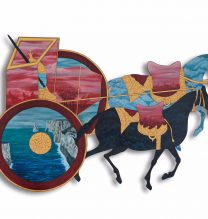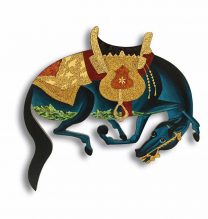Out of Context
Amirhossein Bayani
Out of Context
The series deals with politics. Not politics of emancipation, but power politics. With an utterly critical approach, it is trying to confront the part of politics that is zeroing in on the entirety of human existence and is trying hard to annihilate it. It is as if we are facing the mere fact which directs all the ways towards economic globalization and art globalization. It goes without saying to considering this issue exhaustively in a single series is impossible. Thus, it is focusing on how the subject is colonized by the politics of power. It talks about the part in which the politics of power acts subtly with violence and with a fashionable appearance! , emptying the subjects of their substance, changing identities, perpetually attacking the organic unity of subjects, taking care of everything, repeatedly manipulating the reality, advertising it, and finally making them authentic so much so that any critical approach would be immediately accused of being reactionary and recessive: an intricate mechanism that owes its very existence to creating crisis.
Persian forms are pictures in tiny scales, with disorderly compositions, that generally make a unique, unified experience for the viewer. Commonly, they narrate a story that exists outside of them: they depend on a different context. They are very gentle and poetic, even when they narrate the most violent scenes; according to their different eras, they have their particular stylistic characteristics. The elements are generally idealized, they emphasize details, and they have their own perspective. We can go on talking and doing research about Persian images for years.
In this series, I have considered all the elements of Persian images, except their nature. In the first stage of using violence, I have cut out a piece out of them and have taken them out of their context. Then I have blown them up, much larger than their original size, which is to say I have aggrandized them, it is as if we are seeing microscopic images! It is as if they are being zoomed in. It is as if they are control samples. In the next stage, I realized that the aesthetic inside them is not enough, so I decided to bring in a new kind of aesthetic. I poured their surrounding nature, which was working properly as context for the figures’ initial conditions, into them and I even gave them ideas! I even changed the material of technical approach and led the technical part to a direction that I wanted.
What we eventually see is only reminiscent of Persian painting, and they are even more seductive and apparently self-contained. But they are in fact new subjects emptied of their essence. Lost and bewildered, they live in white contexts on the walls to which they do not belong.
This show is aimed at capturing the essence of art in a paradoxical manner in order to establish a dialogue between the aesthetics of art and potential emancipation latent in politics and to admit standing within the circle of power while keeping possibilities for emancipation in perspective.




















